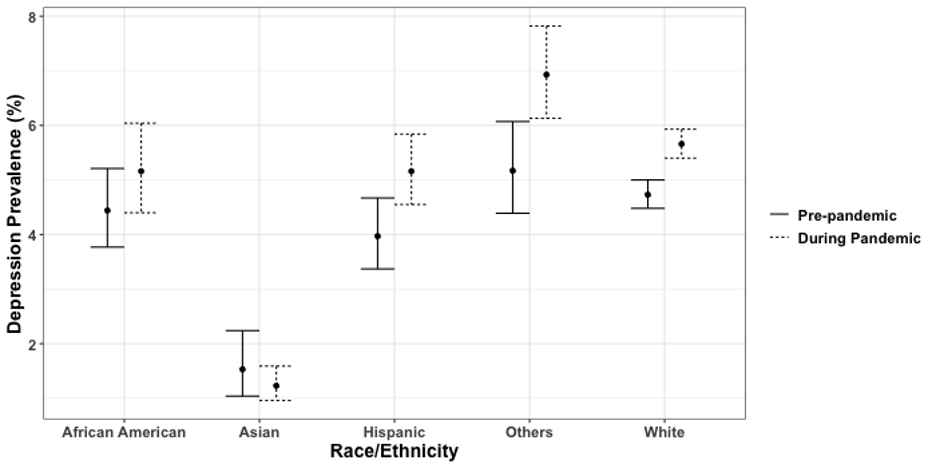Mental Health 2
Session: Mental Health 2
774 - Impact of the Covid-19 Pandemic on the Prevalence of mental health concerns and Healthcare Utilization by children with mental health concerns in the United States
Saturday, April 26, 2025
2:30pm - 4:45pm HST
Publication Number: 774.5542
Ashley Alexander, The Brooklyn Hospital Center, Brooklyn, NY, United States; Majo Joseph, The Brooklyn Hospital Center, Brooklyn, NY, United States; Noah P. Kondamudi, THE BROOKLYN HOSPITAL CENTER, Brooklyn, NY, United States; Nandini Nair, THE BROOKLYN HOSPITAL CENTER, Brooklyn, NY, United States; Abhinav Thakral, UCSF Benioff Children's Hospital San Francisco, San Francisco, CA, United States

Ashley Alexander, MD (she/her/hers)
Emergency medicine residency
The Brooklyn Hospital Center
Brooklyn, New York, United States
Presenting Author(s)
Background: Depression and anxiety are amongst the most commonly diagnosed mental health concerns amongst children 3-17 years of age in the United States, with 9.4% reporting anxiety and 4.4% having depression, according to latest public health statistics in 2016 1. Healthcare disparities for children with mental health concerns can arise from various factors, including socioeconomic status, race/ethnicity, geographic location, and access to healthcare services. These disparities exist in terms of access to care, stigma and discrimination, and quality of care 2. On top of these disparities, the pandemic further disrupted all healthcare services
Objective: Research Question (s)-
● Was there an impact of the Covid pandemic on the prevalence and severity of mental health concerns on a national scale? If so, what was the impact?
● Were there any racial/ethnic disparities in the prevalence and severity of mental health concerns during the pandemic?
Design/Methods: a. Study design: nonequivalence control group design
b. Subjects: Participants in the National Survey of Children’s Health (NSCH) Survey from the years 2016- 2021
c. Setting: National Level Survey data d. Predictor variables:
log(Healthcare utilization )= 𝛽0+ 𝛽1𝑝𝑎𝑛𝑑𝑒𝑚𝑖𝑐 𝑡𝑖𝑚𝑒+ 𝛽2 mental health concerns + 𝛽3 𝑝𝑎𝑛𝑑𝑒𝑚𝑖𝑐 𝑡𝑖𝑚𝑒 𝑥 mental health concerns +𝛽4 𝑎𝑔𝑒 + 𝛽5𝑠𝑒𝑥 + 𝛽6 𝑆𝐸𝑆 + 𝛽7 race/ethnicity + 𝜀
We will conduct a similar regression with mental health concerns and its severity regressed on the same confounders as above.
Results: The prevalence of anxiety was 9.14% (8.82, 9.46) during the pre-pandemic time-period and 11.23 (10.88, 11.58) during the pandemic. The ratio of prevalence of anxiety during the pandemic versus before the pandemic was 1.229 (1.173, 1.288), p < 0.001
The prevalence of depression was 4.37% (4.13, 4.61) during the pre-pandemic time-period and 5.33% (5.09, 5.58) during the pandemic. The ratio of prevalence of depression during the pandemic versus before the pandemic was 1.22 (1.135, 1.311), p < 0.001.
Pandemic related differences in the prevalence of anxiety (p = 0.704) and depression (p = 0.615) were similar for different racial-ethnic groups
Conclusion(s): There was an increase in the prevalence of anxiety and depression amongst children during the pandemic and these differences were similar across different racial-ethnic groups
Anxiety Prevalence
.png) Anxiety Prevalence in Different Races/Ethnicities
Anxiety Prevalence in Different Races/EthnicitiesDepression Prevalence
 Depression Prevalence in Different Races/Ethnicities
Depression Prevalence in Different Races/Ethnicities
